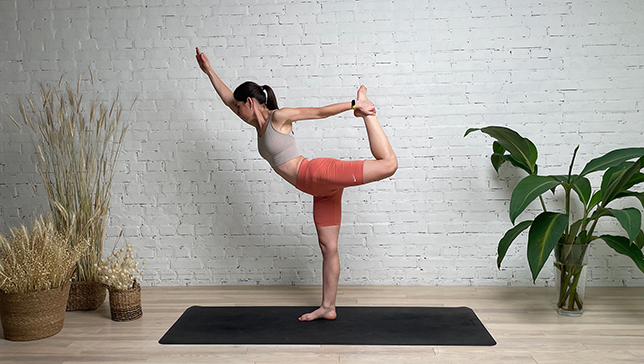Dancer Pose - Natarajasana

Contents
Dancer pose or Natarajasana in Sanskrit, where ‘Nata’ means ‘dancer’ and ‘Raja’ means ‘Lord or King’. Dancer Pose is also attributed to Lord Shiva who is called Lord of the Dance. This vigorous and beautiful pose is dedicated to Lord Shiva, who is also the fountain and source of Yoga.
This yoga pose is considered as an advance level yoga pose and requires repeated practice to get it perfect and right. The focus is mainly on the twisting of the middle back in order to grab the foot and the strength of the legs and arms to go beyond the natural stretch. Dancer Pose is considered a base pose as dancer pose variations can be derived from this pose. Dancer Pose helps boost energy in the body and hence can be included in flow yoga sequences.
Pose Detail
- Difficulty: Advanced, Intermediate
- Body Position: Backbend Yoga Poses, Standing Yoga Poses
- By Type: Balancing Yoga Poses, Chest Opening Yoga Poses, Flexibility Yoga Poses, Hip Opening Yoga Poses, Shoulder Opening Yoga Poses, Strengthening Yoga Poses
- By Benefit: Yoga Poses For Stress Relief
Step-by-Step Instructions
Benefits and Contraindications
Improves balance Improves postural awareness
Can boost energy and fight fatigue
Can help build confidence and empowerment
Improve body awareness
Improves posture and counteracts the effects of sitting and computer work
Strengthens your core and back muscles
Stretches your chest and shoulders
Standing Leg: strengthens the front of your hips (hip flexors), your thighs (while also stretching the back of your thighs/hamstrings), shins, and ankles
Lifted Leg: Strengthens your gluteals and back of thigh (hamstrings). Stretches the front of your hip (hip flexors), front on your thigh (quadriceps), and ankle
Hip pain, hip arthritis, or a hip replacement
Hamstring or groin tear or injury
Acute back pain or injuries, including surgeries, arthritis, disc bulging or herniation, or SI (sacroiliac) pain
Hernia
Shoulder injuries
Photo poses in different angles


Tips For Beginners
- Try using a Strap to hook around your lifted foot. You can either hold it with your right hand or lengthen the strap to the point where you could get both hands holding the strap. This position with your arms and hands will prep you for the advanced and full version of the pose.
- Be cautious to prevent falls if you have poor balance. Consider pose variations using a chair or the wall for stability.
Tips For Advanced Practitioners
- To advance the pose, you could try bringing both hands overhead and grabbing hold of the lifted foot with your hands. When grabbing hold with both hands, be mindful to keep both arms knitted into the body, with elbows close to the ears. Be mindful to keep your shoulders drawn down your back.
Frequently Asked Questions
Variations
- King Dancer Pose B Aerial
- Dancer Pose in front of a chair or wall
- Dancer on a chair
- King Dancer Pose B Foot Aerial
- Dancer Pose with a wheel
- King Dancer Pose B
- Manta Ray Pose Aerial
- Dancer Pose II
- Standing Bow Pose
- Dancer Pose with a strap
- Mermaid Dancer
- Scorpion Dancer
- Standing Full Split
Top Preparatory Poses
Top Follow-Up Poses
- Mountain Pose
- Tree Pose
- Dancer Pose II